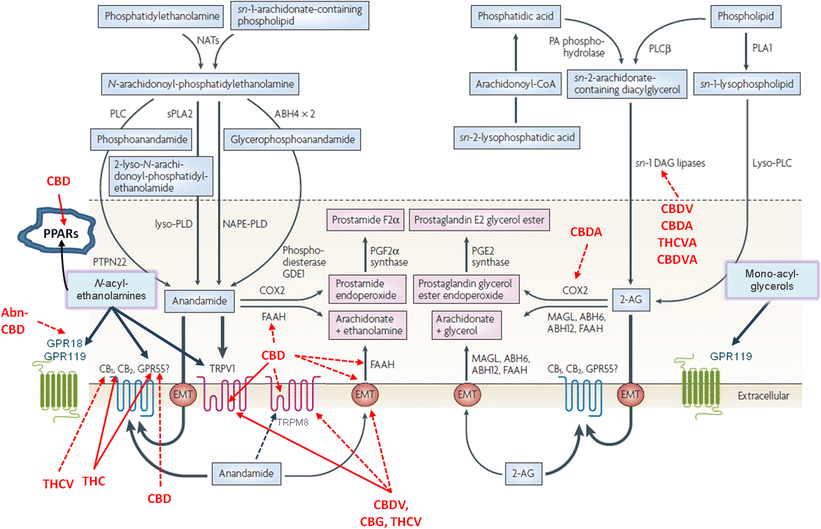
Cannabis 101: The Health Effects of Cannabis and Cannabinoids
NAM: The Health Effects of Cannabis and Cannabinoids
Cannabis 201: Biology and Physiology
Objectives:
-
Understand the endocannabinoid system’s role in health and disease
-
Have an overview of the role of Cannabis in the human body
The Role of the Endocannabinoid System in the Human Body

The effects of cannabis on the central nervous system. Brain areas in the central nervous system (in black) and their physiological functions (in red) are listed alongside potential effects of THC and CBD (in blue and green), respectively.
Abbreviations: THC, (-)-∆9-trans-(6aR,10aR)-tetrahydrocannabinol; CBD, cannabidiol.


The endocannabinoid system and CB1/CB2 distribution. (A) The mechanism of action of the endocannabinoid system is depicted, with human endocannabinoids AEA or 2-AG binding to CB1 to initiate a signaling cascade through the release of neurotransmitters. THC is also able to bind to CB1, exerting its effects on the central nervous system and peripheral system. (B) Distribution of CB1 and CB2 in the body. CB1 is concentrated in the central and peripheral nervous systems. CB2 is more abundant in the immune system and, to a lesser degree, in the nervous system.
Abbreviations: CB1/CB2, cannabinoid receptor 1/cannabinoid receptor 2; AEA, anandamide; 2-AG, 2-arachidonooylglycerol; THC, (-)-∆9-trans-(6aR,10aR)-tetrahydrocannabinol.
The Endocannabinoid System and its Modulation by Phytocannabinoids

Complexity, redundancy, and promiscuity of the endocannabinoid system: the “endocannabinodome” and the interactions therewith of plant cannabinoids.

Complexity, redundancy, and promiscuity of the endocannabinoid system: the “endocannabinodome” and the interactions therewith of plant cannabinoids. Several often concurrent pathways underlie both the biosynthesis and the inactivation of the 2 most studied endocannabinoids, anandamide, and 2-arachidonoylglycerol (2-AG). Anandamide biosynthetic precursors, the N-arachidonoyl-phosphatidylethanolamines, are produced from the remodeling of phospholipids via the action of N-acyl-transferases (NATs). They are then converted to anandamide, either in 1 step, by N-acyl-phosphatidylethanolamine-selective phospholipase D (NAPE-PLD), or in sequential steps, i.e. by α,β -hydrolase-4 (ABHD4) followed by phosphodiesterase GDE1; or soluble phospholipase A2 (sPLA2) followed by lysophospholipase D (lyso-PLD); or by phospholipase C (PLC) enzymes followed by phosphatases such as PTPN22. The sn-2-arachidonate-containing diacylglycerols serving as biosynthetic precursors for 2-AG are in most cases produced from the action of PLCβ but can also come from phosphatidic acid (PA) via PA phosphohydrolase.
Cannabinoids as antioxidants and neuroprotectants
The cannabinoids are found to have particular application as neuroprotectants, for example in limiting neurological damage following ischemic insults, such as stroke and trauma, or in the treatment of neurodegenerative diseases, such as Alzheimer's disease, Parkinson's disease and HIV dementia.
The endogenous cannabinoid (endocannabinoid) system regulates a diverse array of physiological processes and unsurprisingly possesses considerable potential targets for the potential treatment of numerous disease states, including two receptors (i.e., CB1 and CB2 receptors) and enzymes regulating their endogenous ligands N-arachidonoylethanolamine (anandamide) and 2-arachidonyl glycerol (2-AG). Increases in brain levels of endocannabinoids to pathogenic events suggest this system plays a role in compensatory repair mechanisms. Traumatic brain injury (TBI) pathology remains mostly refractory to currently available drugs, perhaps due to its heterogeneous nature in etiology, clinical presentation, and severity.
Phytocannabinoids are cannabinoids that occur naturally in the cannabis plant. The classical cannabinoids are formed through decarboxylation of their respective 2-carboxylic acids (2-COOH), a process which is catalyzed by heat, light or alkaline conditions.
These cannabinoids are abundant in the viscous resin that is produced by glandular structures in the cannabis plant called trichomes. This resin is also rich in terpenes, which are responsible for the characteristic smell of the cannabis plant. The phytocannabinoids are mostly insoluble in water but are soluble in alcohol and fat and other non-polar organic solvents. In alkaline conditions, they can form water-soluble phenolate salts, being essentially phenols.
Of over 480 different compounds present in the cannabis plant, only around 66 have been identified as cannabinoids The most well known of these compounds is the delta-9-tetrahydrocannabinol (Δ9-THC), the main psychoactive ingredient in the plant. Other common cannabinoids include cannabidiol (CBD) and cannabinol (CBN).


